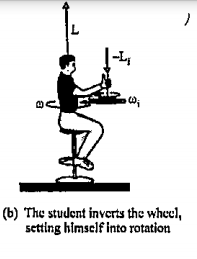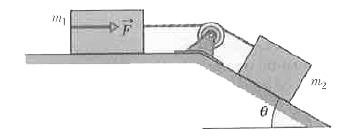A student weighing 667N rides a steadily rotating Ferris wheel (student sits upright). At the highest point , the magnitude of the normal force →N on the student from the seat is 556 N. The magnitude of →N, if the wheel's speed is doubled is
223 N
111 N
444 N
332 N
The correct Answer is:A
Step by step video, text & image solution for A student weighing 667N rides a steadily rotating Ferris wheel (student sits upright). At the highest point , the magnitude of the normal force vec(N) on the student from the seat is 556 N. The magnitude of vec(N), if the wheel's speed is doubled is by Physics experts to help you in doubts & scoring excellent marks in Class 12 exams.
Topper's Solved these Questions
- BOOK - TARGET PUBLICATIONCHAPTER - CIRCULAR MOTIONEXERCISE - COMPETITIVE THINKING102videos
CIRCULAR MOTION
- BOOK - TARGET PUBLICATIONCHAPTER - CIRCULAR MOTIONEXERCISE - EVALUATION TEST11videos
CIRCULAR MOTION
- BOOK - TARGET PUBLICATIONCHAPTER - CIRCULAR MOTIONEXERCISE - EVALUATION TEST11videos
CIRCULAR MOTION
- BOOK - TARGET PUBLICATIONCHAPTER - ATOMS, MOLECULES AND NUCLEI EXERCISE - Evaluation test19videos
ATOMS, MOLECULES AND NUCLEI
- BOOK - TARGET PUBLICATIONCHAPTER - CURRENT ELECTRICITY EXERCISE - Evaluation Test6videos
CURRENT ELECTRICITY
Similar Questions
A circular motion addict of mass 80 kg rides a Ferris wheel around in a vertical circle of radius 12 m at a constant speed of 5.5 m/s (a) What is the period of the motion? What is the magnitude of the normal force on the addict from the seat when bothh go through (b) the highest point of the circular path and (c) the lowest point?
View SolutionAs every amusement park fan knows, a Ferris wheel is a ride consisting of seats mounted on a tall that rotates around a horizontal axis. When you ride in a Ferris wheel at constant speed, what are the directions of your acceleration →a and the normal force →FN on you (from the always upright seat) as you pass through (a) the highest point and (b) the lowest point of the ride? (c) How does the magnitude of the acceleration at the highest point compare with that at the lowest point? (d) How do the magnitude of the normal force compare at those two points?
View Solution
Knowledge Check
- Question 1 - Select One
The sum of two forces at a point is 16N. if their resultant is normal to the smaller force and has a magnitude of 8N, then two forces are
A6N, 10NB8N, 8NC4N, 12ND2N, 14N - Question 2 - Select One
If →F=(5ˆi+2ˆj−4ˆk)N, the magnitude of force is
A45 NB3√5NC10 ND20 N
Sum of magnitudes of the two forces acting at a point is 16N if their resultant is normal to the smaller forces and has a magnitude 8N then the forces are .
View SolutionThe centre in figure has dimensions m by h and the ramp is inclined at θ to the horizontal. Find the effective point of application of the normal force →n.
View SolutionYour are riding on a Ferris wheel that is rotating with a constant speed . The car in which you are riding always maintain its correct upward orientation , it does not invert.
a. What is the direction of the normal force on you form the seat when you are at the top of the wheel ?
i. upward ii. downward .iii. impossible to determine
b. From the same choices, what is the direction of the net force on you when you are at the top of the wheel?View SolutionFigure shows a student, sitting on a stool that can rotate freely about a vertical axis. The student, initially at rest, is holding a bicycle wheel whose rim is loaded with lead and whose moment of inertia is I about its central axis. The wheel is rotating at an angular speed ωi from an overead perspective, the rotation is counter clockwise. The axis of the wheel point vertical, and the angular momentum →Li of the wheel points vertically upward. The student now inverts the wheel, as a result, the student and stool rotate about the stool axis. With what angular speed and direction does the student then rotate? (The moment of inertia of the student+stool+wheel system about the stool axis is I0)

 View Solution
View SolutionA constant horizontal force of 10N is applied at the centre of a wheel of mass 10kg and radius 0.30m. The wheel rolls without slipping on the horizontal surface, and the acceleration of the centre of mass is 0.60m/s2.
a. What are the magnitude and direction of the frictional force on the wheel?
b. What is the rotational inertia of the wheel about an axis through its centre of mass and perpendicular to the plane of the wheel?View SolutionFigure 5-59 shows a box of mass m2=1.0 kg on a friction-less plane inclined at angle θ=30∘. It is connected by a cord of negligible mass to a mass m1=2.5 kg on a horizontal frictionless surface. The pulley is frictionless and massless. (a) If the magnitude of horizontal force →F is 2.3 N, what is the tension in the connecting cord? (b) What is the largest value the magnitude of →F may have without the cord becoming slack?
 View Solution
View Solution

